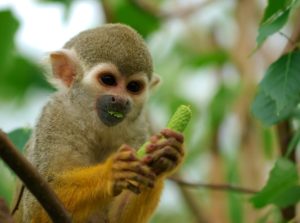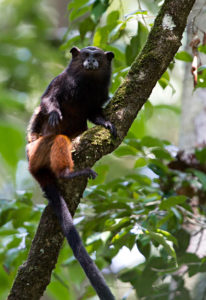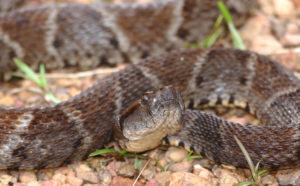Now the serpent was more subtle than any beast of the field which the Lord God had made. Genesis 3: 1
 It was a mixed band of squirrel monkeys and saddle-back tamarins that had attracted my attention. Up ahead I could see their swift movements among the branches of a towering Inga tree. The calls of these
It was a mixed band of squirrel monkeys and saddle-back tamarins that had attracted my attention. Up ahead I could see their swift movements among the branches of a towering Inga tree. The calls of these  little primates could easily be mistaken for the vocalizations of birds. In fact, it was their calling that had originally drawn my attention to the tree they were exploring. This tree was located only a few hundred yards from the majestic Amazon River in northeastern Peru. Here the Neotropical rainforest presented a most splendid exhibit of biodiversity. I was walking within a forest which held ten percent of the world’s plant species. Dispersed on and beneath the impressive community of forest giants – kapok, fig, pacay, Brazil nut – lived a multitudinous assemblage of fungi, insects, spiders, frogs, lizards, snakes, birds, and mammals. Stepping along the trail toward the little primates, I squeezed through a rich undergrowth of ginger, irapay and pona palm, philodendron, melastoma, and maranta. Although the comparison is shopworn, it really was akin to walking within a crowded greenhouse. In the background I heard the periodic calls of screaming piha’s. The piercing, exotic whistles of these rather nondescript, grayish brown birds cried out to me – “rainforest, this is tropical rainforest”. (You can hear one at the following link.)
little primates could easily be mistaken for the vocalizations of birds. In fact, it was their calling that had originally drawn my attention to the tree they were exploring. This tree was located only a few hundred yards from the majestic Amazon River in northeastern Peru. Here the Neotropical rainforest presented a most splendid exhibit of biodiversity. I was walking within a forest which held ten percent of the world’s plant species. Dispersed on and beneath the impressive community of forest giants – kapok, fig, pacay, Brazil nut – lived a multitudinous assemblage of fungi, insects, spiders, frogs, lizards, snakes, birds, and mammals. Stepping along the trail toward the little primates, I squeezed through a rich undergrowth of ginger, irapay and pona palm, philodendron, melastoma, and maranta. Although the comparison is shopworn, it really was akin to walking within a crowded greenhouse. In the background I heard the periodic calls of screaming piha’s. The piercing, exotic whistles of these rather nondescript, grayish brown birds cried out to me – “rainforest, this is tropical rainforest”. (You can hear one at the following link.)
https://www.youtube.com/watch?v=zY_GrQL8W_U
 I listened as a continuous series of high-pitched squeaks, trills, and
I listened as a continuous series of high-pitched squeaks, trills, and  staccato screeches produced by the busy monkeys issued from the trees just ahead of me. Lifting my binoculars to my eyes, I once again scanned ahead and saw that the roving assemblage was much closer now. I could clearly make out individual animals within the primate band. If I could only get a little nearer I would really be able to observe their behavior. Lowering my binoculars, I began to move closer to the little animals. With one foot thus poised in mid-stride, there suddenly came to me a second thought. The how or why of this sudden, unbidden neuronal signal has puzzled me for many years. Whatever the source, there abruptly arose in my mind a delicate warning. Be careful it said. Watch where you step it whispered. Heeding this cautioning counsel without question, I glanced down at the trail. Lying there, directly in the path of my next step, was a snake. My heart made a sudden lunge into a higher gear. This was not just any snake. Resting there at my feet, its head slightly raised from the ground in alertness was a fer-de-lance, considered by many to be the most dangerously venomous snake in the Neotropics.
staccato screeches produced by the busy monkeys issued from the trees just ahead of me. Lifting my binoculars to my eyes, I once again scanned ahead and saw that the roving assemblage was much closer now. I could clearly make out individual animals within the primate band. If I could only get a little nearer I would really be able to observe their behavior. Lowering my binoculars, I began to move closer to the little animals. With one foot thus poised in mid-stride, there suddenly came to me a second thought. The how or why of this sudden, unbidden neuronal signal has puzzled me for many years. Whatever the source, there abruptly arose in my mind a delicate warning. Be careful it said. Watch where you step it whispered. Heeding this cautioning counsel without question, I glanced down at the trail. Lying there, directly in the path of my next step, was a snake. My heart made a sudden lunge into a higher gear. This was not just any snake. Resting there at my feet, its head slightly raised from the ground in alertness was a fer-de-lance, considered by many to be the most dangerously venomous snake in the Neotropics.
So quietly it rested there. So delicately it blended with the brownish soil and dead leaves. So noiselessly had it appeared at my feet. So horrible could be the effects of its bite. The surrounding forest, and its inhabitants, seemed to have momentarily disappeared. The sounds of birds and monkeys hung suspended in the air. The universe abruptly consisted of only two beings – the snake and myself. I froze in silent contemplation of what might have been had I allowed my footfall. 
“Iron of the lance” so the snake might be called in the English translation. As I gazed down at the serpent, the name seemed eminently appropriate. The lance-shaped head, so beautifully proportioned, was well delineated from the body by a slender neck. The snake gazed upward at me, seemingly as unsure of the next move as I was. This specimen was only three feet or so in length, roughly half its potential adult size. Nevertheless, I was confident that the toxicity of this snake’s venom would be every bit as potent as an adult’s. The venom of pit-vipers such as this one is a complex brew of organic chemicals. I once heard snake venom described as acting like a physiological hand grenade when introduced into another organism. This description seems perfectly accurate as envenomation initiates a cascade of destructive consequences. Considerable pain and swelling are common initial symptoms of viper bite. But, there may be much worse to come. Contained within their modified saliva are enzymes such as phospholipase which digests cell membranes. Such lysins can destroy massive areas of soft tissue – skin and muscle for example. Should you be curious as to the human results of such tissue devastation, do a Google image search for fer-de-lance bite. But be forewarned; the images you’ll find are not for those who quail at the sight of horrific injury. 
Other venom components work to cause internal physiological damage. Hemolysins attack red blood cells, rupturing their membranes and destroying their ability to carry oxygen. Blood vessel walls are assaulted causing them to leak. As a result, bite victims may exhibit hematuria (blood in their urine) or hematochezia (blood discharged per anum). Blood loss may cause a precipitous drop in blood pressure with the classic symptoms of shock, rapid pulse and respiration rates ensuing. Venoms often contain cardiotoxins which attack heart muscle cells leading to arrhythmias or cardiac collapse. As you will clearly see, venom’s full scale assault on body structure and function make envenomation by a viper an experience to be diligently avoided.
I continued to regard the fer-de-lance with caution and respect. It remained in the locomotor posture in which I had first seen it and showed no coiling or other signs of aggression. The snake, like nearly all I have encountered over the years, indicated a strong willingness to leave alone and be left alone. But, I also knew that I had been fortunate. This species, contrary to its present behavior, is often a cranky fellow who doesn’t always display such gentlemanly conduct. Leaving it lying in the trail didn’t seem like such a good idea. This was a pathway frequently used by tourists and their guides. Glancing about, I found a stout but slim tree branch a few feet in length. I gently eased the limb under the snake. A quickening of the snake’s tongue-flicking behavior was the only reaction given as I gradually raised the creature from the trail. The snake easily balanced itself on the branch as I carried it several feet from the path and lowered it back onto the ground. I took a few photographs and then, relieved at the uneventful conclusion to such a close encounter with an exceedingly dangerous animal, I returned to my search for monkeys.
Strangely enough, I had not seen the last of this snake. Two days later I ventured down this same trail along with a group of rainforest workshop participants and their guide. I distinctly recalled the spot where I had previously encountered the viper. Even though it isn’t uncommon for vipers to lie in wait for prey for rather extended periods of time, I was mildly surprised to see that it was still lying in the exact spot in which I had placed it. The serpent was again on its best behavior and allowed our group to crowd around (relatively speaking) to take photos and share the excitement of seeing what is normally a somewhat elusive animal.
But still, my mind reverted to my initial encounter and that mysterious sixth sense that had warned me to look down. I have heard of others who have had a similar experience. Tropical biologist Adrian Forsyth recounted a comparable happenstance in Costa Rica; this also involved a pit-viper. Walking along a forest path, Forsyth described halting, “in midstep just as a mottled brown missile tipped with a gaping mouth launched itself at my toes.” He recalled reacting in an instinctive manner to draw his foot out of the way before he even mentally considered the action. Renowned biologist Edward O. Wilson has something to say on this subject as well. Wilson is recognized as the “father of sociobiology”. This discipline is considered controversial by some because it implies an evolutionary origin for many aspects of human social behavior. In other words, there are some things we do that are derived as a result of the adaptive value they provided our far-distant ancestors. Wilson argues that such social actions are programmed into our genetic makeup. A positive example might be the human propensity to form maternal bonds between mother and child. A negative illustration would be the human tendency toward tribalism and thus distrust of those who differ from us in ethnicity or religion. But there may be other adaptive behaviors that lurk deeper in our psyche.
My run in with the fer-de-lance, and its similarity to the snake experiences described by others, makes me think Wilson is likely correct. What he might describe as the “startle response” seems to be deeply ingrained in the human mind. This does indeed suggest an underlying genetic , thus inherited, component for our ability to sense imminent danger. To quote Dr. Wilson: “The brain appears to have kept its old capacities, its channeled quickness. We stay alert and alive in the vanished forests of the world.” Or, in my case, the not yet vanished forests of the world.*
*There is an interesting footnote to this story. Not long after I had written this essay a friend referred me to a piece of research recently published in the Proceedings of the National Academy of Sciences. Anthropologist Lynne Isbell had a snake experience in Africa similar to mine. This prompted her to team up with researchers in Japan studying the reaction to snakes by monkeys that had never seen serpents. These studies showed that the visual system of the brain of humans, apes, and monkeys contain neurons that are particularly sensitive to snake images. This area of the brain is called the pulvinar. It now appears that the human brain does indeed have the innate ability to recognize the presence of a serpent well before we are consciously aware of its company.
Photo Credits:
squirrel monkey Luc Valour at commons.wikimedia.org
saddle-back tamarin Giovannie Mari at commons.wikimedia.org
fer de lance Bernard DuPont at commons.wikimedia.org
